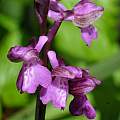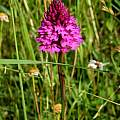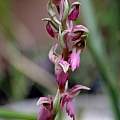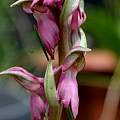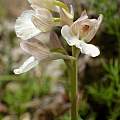Anacamptis Rich. is a genus in the Orchidaceae family. Created by the French botanist Louis Claude Richard in 1817, the name is derived from the Greek word anakamptein, meaning "to bend backwards". Since a reorganisation by Pridgeon et al in 1997 the genus contains about 20 species, several of which were transferred from Orchis. The Genus is actually closer related to Serapias, with which it can form rather spectacular intergeneric hybrids. Several species are easy in culture, most are adopted to seasonal dry habitats.
Species
Anacamptis morio (L.) R.M.Bateman, Pridgeon & M.W.Chase is the most widespread species of the genus, spanning from Ireland in the northwest, southern Sweden and Lithuania in the northeast, the shores of Tunisia to the south, and to Israel in the southeast. While there are up to 6 subspecies accepted, most of its range is occupied by subspecies morio. Despite the wide range, this species is highly threatened due to its low nitrogen tolerance and the loss of oligotrophic grassland. A. morio usually passes its hardiness to hybrid offspring and is helpful in bringing traits of more spectacular Mediterranean species into northern gardens.
The leaves emerge in late winter sheathing the inflorescence of typically 5-20 flowers. The color forms vary from purple to white with wide variations of both the base color and the lip spots. The common trait in all forms is the greenish nervature of the petals forming the helmet. The images show a plant of the typical color form cultivated by Martin Bohnet. It is still potted, while the sibling which was planted out has fallen victim to slugs.
Anacamptis papilionacea (L.) R.M.Bateman, Pridgeon & M.W.Chase is one of the species transferred from Orchis at the end of the 1990s. With three subspecies, its range covers Spain and Portugal, the North coast of Africa from Morocco to Tunisia, Italy and part of the Balkans and reaching Azerbaijan in the east. The inflorescence consists of fewer but bigger single flowers than in other Anacamptis, with delicate lines spreading from the base to the rim of the lip. The plants prefer an open, sunny habitat, but are tolerant of a wide spectrum of soil pH. A lack of hardiness keeps them from reaching higher altitudes. Main time of growth is the wet, Mediterranean winter. The flowers open up between March and the beginning of May, depending on the latitude, and seeds ripen before the dry summer sets in.
The first photo shows a plant cultivated by Johannes-Ulrich Urban who finds it easy as a potted specimen in Portugal after a first year of settling in. This specimen seem to be his local subspecies messenica (Renz) H.Kretzschmar, Eccarius & H.Dietr. (note: in 2022 not separated to subspecies level). The second photo by Martin Bohnet shows subspecies papilionacea, the dominant form in Italy and parts of the Balkans with its more narrow lip, which he grows under frost-free conditions.
Anacamptis pyramidalis Rich. commonly called the pyramidal orchid is the type species of the genus and is native to southwestern Eurasia, from western Europe through the Mediterranean region eastwards to Iran. Unfortunately, it is the one species which is rather difficult in culture. Though it can be locally abundant, it is generally threatened by anthropogenic introduction of nitrogen in it's habitats, marking it as a plant sensitive towards competition. The coloration of the flowers varies besides the occasional albino from pale pink to dark purple, with usually darker populations occurring in higher habitats. The photographs 1-3 by Caroline Langensiepen of plants growing in habitat in Wales, photo 4 by Martin Bohnet of a plant on the Swabian Jura.
Anacamptis sancta (L.) R.M. Bateman, Pridgeon & M.W. Chase, syn. Orchis sancta, the holy orchid, is another one of the species transferred from Orchis in 1997. The epithet denominates the "holy land" Israel as type origin, though in fact the species is common throughout the coastal regions of the Levant, Turkey, Crete, Cyprus and many islands of the Aegean Sea.
During the growth period in winter they prefer humid though well drained locations like natural drainage channels, which may fall completely dry during the flowering period in April (southernmost populations) to June. At that time of the year, they are usually the last flowering orchid in the area and have mostly lost their unspotted basal leaves. The up to 30 flowers per spike range from pale to deep pink in lip color, always combined with a greenish, closed helmet with a pronounced pointed tip. The long lip is lobed again with pointed tips. Pictures show a plant grown under frost-free glass by Martin Bohnet.
Hybrids
Anacamptis x gennarii (Rchb.f.) H.Kretzschmar, Eccarius & H.Dietr. is a nothospecies which is very variable in nature, since both parents, Anacamptis morio and Anacamptis papilionacea have several subspecies in their large overlapping Mediterranean range. In addition to these natural hybrids there is a special horticultural interest in artificial crosses involving the hardy German form of Anacamptis morio, which usually passes its hardiness on to the offspring, while at the same time allowing the papillionacea parent to dominate the flower form.
The following picture by Martin Bohnet shows a cross between A. morio alba and A. papillionacea rubra, which proved to be hardy in southern Germany.

